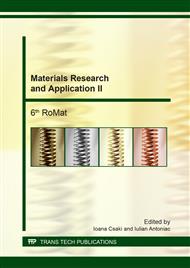[1]
M.L. Armstrong, E. Ekmark, B. Brooks, Body piercing: promoting informed decision making. J Sch Nurs 112 (1995) 20-25.
Google Scholar
[2]
M.L. Armstrong, You pierced what? Ped Nurs, 22 (1996) 236-238.
Google Scholar
[3]
D. Rabinerson, E. Horowitz, Genital piercing. Harefuah, 144 (2005) 736-738.
Google Scholar
[4]
M. Beers, J. Meires, L. Loriz, Body piercing. The Nurse Practitioner 32(2) (2007) 60, 269-306.
DOI: 10.1097/00006205-200702000-00011
Google Scholar
[5]
M.L. Armstrong, J.R. Koch, J.C. Saunders, A.E. Roberts, D.C. Owen, The whole picture: risks, decision making, purpose, regulations, and the future of body piercing, Clin Dermatol, Jul-Aug, 25(4) (2007) 398-406.
DOI: 10.1016/j.clindermatol.2007.05.019
Google Scholar
[6]
M.L. Armstrong, A.E. Roberts, D. Owen, et al, Toward building a composite of college student influences with body art. Issues Compr Pediatr Nurs 27 (2004) 277-295.
DOI: 10.1080/01460860490884183
Google Scholar
[7]
M.A. Gold, C.M. Schorzman, P.J. Murray et al, Body piercing practices and attitudes among urban adolescents. J Adolesc Health 36 (2005) 352 - 415.
DOI: 10.1016/j.jadohealth.2004.07.012
Google Scholar
[8]
A.E. Laumann, A.J. Derick, Tattoos and body piercing in the United States: a national data set. J Am Acad Dermatol 55 (2006) 413-421.
DOI: 10.1016/j.jaad.2006.03.026
Google Scholar
[9]
A. Bors, I. Antoniac, C. Cotrut, A. Antoniac, M. Szekely, Surface Analysis of Contemporary Aesthetic Dental Filling Materials after Storage in Erosive Solutions, Materiale Plastice, Volume 53, No. 4, (2016) 607- 611.
Google Scholar
[10]
I. Antoniac, M.D. Vranceanu, A. Antoniac, The influence of the magnesium powder used as reinforcement material on the properties of some collagen based composite biomaterials, Journals of optoelectronic and advanced materials, Volume 15, Issue 7-8, (2013).
Google Scholar
[11]
H. Manolea, I. Antoniac, M. Miculescu, R. Rica, A. Platon, R. Melnicenco Variability of the composite resins adhesion with the dental substrate preparation and the used adhesive type, Journal of adhesion science and technology, Volume 30, Issue 16, (2016).
DOI: 10.1080/01694243.2015.1091676
Google Scholar
[12]
M.L. Armstrong, A.E. Roberts, J.R. Koch, et al, Investigating the removal of body piercings. Clin Nurs Res 16 (2007), 103-118.
DOI: 10.1177/1054773806298506
Google Scholar
[13]
T. Makkai, I. McAllister, Prevalence of tattooing and body piercing in the Australian communit, Commun Dis Intell 25 (2001), 67-72.
Google Scholar
[14]
S.S. Price, M.W. Lewis, Body piercing involving oral sites, J Am Dent Assoc. 128 (1997), 1017–1020.
Google Scholar
[15]
R. Boardman, R.A. Smith, Dental implications of oral piercing, Oral Health 87 (1997), 23–31.
Google Scholar
[16]
C.S. Farah, D.M. Harmon, Tongue piercing: case report and review of current practice, Aust Dent J. 43 (1998), 387–389.
DOI: 10.1111/j.1834-7819.1998.tb00197.x
Google Scholar
[17]
M.J. Fehrenbach, Tongue piercing and potential oral complications, J Dent Hyg. 72 (1998), 23–25.
Google Scholar
[18]
B.J. Folz, B.M. Lippert, C. Kuelkens, J.A. Werner, Hazards of piercing and facial body art: a report of three patients and literature review, Ann Plast. Surg. 45 (2000), 374–381.
DOI: 10.1097/00000637-200045040-00004
Google Scholar
[19]
A. Campbell, A. Moore, E. Williams, J. Stephens, D.N. Tatakis, Tongue piercing: Impact of time and barbell stem length on lingual gingival recession and tooth chipping, J Periodontol. 73 (2002), 289–297.
DOI: 10.1902/jop.2002.73.3.289
Google Scholar
[20]
D. Ziebolz, E. Hornecker, R.F. Mausberg, Microbiological findings at tongue piercing sites: Implications to oral health, Int J Dent Hyg, 7 (2009), 256–262.
DOI: 10.1111/j.1601-5037.2009.00369.x
Google Scholar


